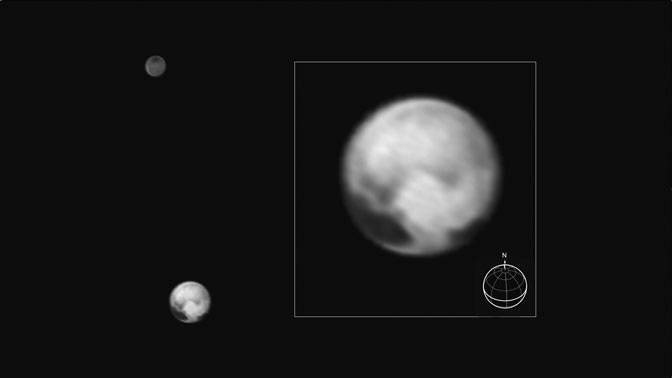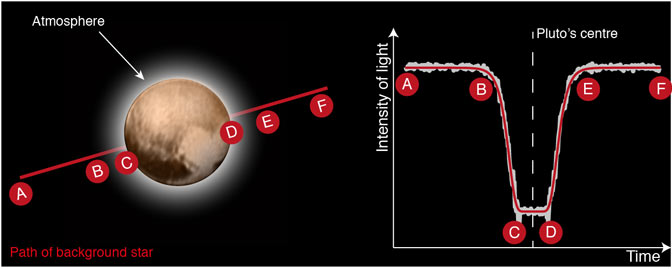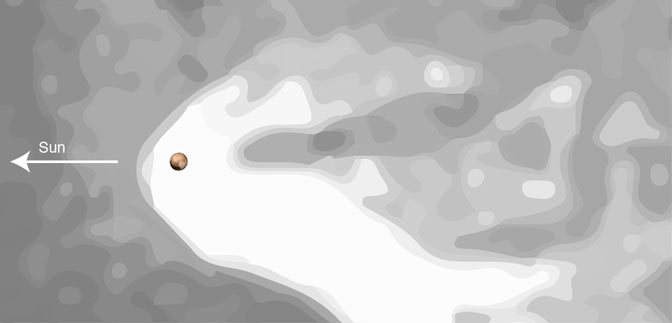Since pre-history humankind has looked up the night skies and watched the wandering stars. On 14th December 1962 NASA’s Mariner 2 spacecraft flew past Venus and started humankind’s initial reconnaissance of our Solar System. On 14 July the New Horizons spacecraft will fly by the dwarf planet Pluto, completing humankind’s initial reconnaissance of our Solar System’s major classes of bodies.
Pluto and its planetary system
A fascinating planetary system awaits New Horizons. More than 32 times further from the Sun than Earth the temperature is a frigid -233°C. Water ice is hard and brittle like rock, but nitrogen can behave like a slush drink or lava and can slowly flow down canyon walls and crater edges.

Since the inception of a mission to Pluto we have discovered many other similar bodies in the Solar System, such as Haumea (2004), Eris (2005), and Makemake (2005). Neptune’s largest moon Triton appears to be an object similar to Pluto but which was captured at some point in the distant past, a violent event that destroyed Neptune’s original system of moons.
One of the most exciting Pluto discoveries made in the last 25 years includes the detection of a tenuous atmosphere made of nitrogen, but with traces of methane and carbon monoxide. The atmospheric pressure on the surface is 0.000015 bars whereas at sea level on Earth this is around 1 bar which is 70000 times thicker than on Pluto. The greenhouse effect associated with methane in the atmosphere means that the atmosphere is at a balmy -173°C, a hundred degrees hotter than the surface.
Measuring an atmosphere from a distance of 5000000000 km
Looking at Pluto in a telescope, the light has taken 4.4 hours to get to us from Pluto, and it took 4.6 hours to get from the Sun to Pluto in the first place. A total round-trip of 9 hours. Near Pluto, the gases in the atmosphere absorb some of the light at characteristic wavelengths of light – some colours in the rainbow are absorbed. Exactly which colours tells us about the atmosphere and what it’s made from.
This is one way we find out about Pluto’s atmosphere. Another way is to see how the light from a distant star gets dimmer as the star goes behind Pluto. This allows us to work out the structure of the. When the star is behind Pluto we only receive light from Pluto, when the star is far away from Pluto we see the full brightness of the star, but when the starlight travels through the atmosphere it appears dimmer than it should be.

This has allowed us to work out that Pluto’s atmosphere extends to over 3000 km from the surface of Pluto – far more extended than Earth’s atmosphere relative to the size of the body. We can also see spikes and changes in shape of the light curve which tell us about winds and haze layers in the atmosphere.
Where does this atmoshpere come from?
Pluto’s atmosphere essentially comes from nitrogen and methane that are frozen as a solid on Pluto’s surface, forming surface ice caps and frost. Sunlight provides enough energy for these to sublimate: turning straight from a solid into a gas just like dry ice does on dance floors and in film studios. Once part of the atmosphere the gas can freeze back onto the surface forming a cycle of sublimation and freezing out.
This cyclical sublimation and freezing is complemented by the escape of Pluto’s atmosphere into space. Over 450 kg of Pluto’s atmosphere escapes every second, some of it being dragged off by the supersonic solar wind flowing past at 500 km per second (about a million miles per hour), in some ways like a giant comet. The sketch below shows the results of a computer model of how Pluto interacts with the solar wind with the shaded regions showing Pluto’s atmosphere being eroded in a patchy and uneven fashion. These processes are part of a slowly shifting equilibrium and is thought to be at least partly responsible for the patterns of colour in Pluto’s surface features.

Pluto’s orbit around the Sun is not a circle and so Pluto can sometimes be very far away from the Sun, sometimes much closer, and is currently moving away from the Sun. Computer models once thought that as Pluto moved away from the Sun the atmosphere would completely freeze-out and collapse onto the surface. However, more recently we’ve seen the atmosphere get thicker and we think this is due to the north pole emerging into sunlight for the first time in 120 years causing nitrogen gas to sublimate increasing the atmospheric pressure.
Depends on details of how ice interacts with sunlight, the subsurface of Pluto, and its environment in the Solar System. New Horizons will be characterising these processes at Pluto for the very first time. Work at Lancaster involves the study of similar atmospheric escape physics at Mars using data from NASA’s MAVEN spacecraft which arrived at Mars last year.
What can images of Pluto tell us?
The new images we are seeing of Pluto are exciting and inspire the Captain Cook in all of us. They do not just tell us about processes occurring in the deep interior and crust, but also how it interacts with its atmosphere and the solar wind. We have estimated that around a km of nitrogen ice has been removed from Pluto’s surface over Pluto’s lifetime. Some of this nitrogen has been lost to the solar wind, ultimately to leave the Solar System, and the rest should have been deposited on Charon. New Horizons images will be examined to find evidence for this effect.
The removal of so much nitrogen ice from the surface will have affected the craters on Pluto in a similar way to how weather has eroded craters on Earth. The amazing images coming back from New Horizons are showing us these craters for the very first time and we will have to be careful in what we infer about Pluto’s history from these surface features.
As measurements come back from New Horizons over the next year space scientists are going to have a very interesting and exciting time ahead!
Links
Disclaimer
The opinions expressed by our bloggers and those providing comments are personal, and may not necessarily reflect the opinions of Lancaster University. Responsibility for the accuracy of any of the information contained within blog posts belongs to the blogger.


